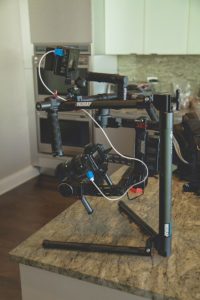DJI RONIN-M GIMBAL STABILIZER V3 NEW VERSION
If you have visited the Digital Media studio located in the Advance Technology building, you have seen many new pieces of camera equipment start to arrive. One such equipment that is set to arrive soon is the Ronin-M 3 Axis Handheld Gimbal Stabilizer from DJI. This piece of camera equipment is simply a beauty when it comes to getting the steady shot you desire. Previously, the Digital Media program had a first addition Glidecam and it was reaching its last leg in performance along with a simple rig that had no other benefit than stationary support, but the horizon is bright for Gulf Coast’s videography department. So, what are some of the pros and cos for this stabilizer and why is it such an important arsenal for upgrading the technology advancements for the Digital Media Program?
Let’s start by looking at the features this bad boy has. This stabilizer can hold cameras weighing up to 8lbs. Which is great addition to the versatility that is needed when you have DSLR’s and their accessories. I personally would only use a DSLR with this stabilizer because of the dimensions. A camcorder might be too large to sit on the supports comfortably. It would also really depend on the camera size. Make sure you check your camera dimensions in comparison with the DJI Ronin’s. The DJI also has a remote for panning and tilting. This feature is meant to be used with a partner as you’re handholding it for operation. This adds a better workflow by making sure you get the shot you want and not necessarily focusing on the technical aspects of the stabilizer. The stabilizer also has software to fine tune the operations that can be downloaded on your phone, which adds to the appeal of why this equipment is a must have. To add, there are features such as silent mode, a stand and fixable mounts to fit your camera’s accommodations. This stabilizer sets itself apart as one of the best stabilizers you can buy that is affordable.
The advancement in this product is the 3-Axis gimbal system. It keeps your body shake from affecting the camera. If you have had any form of stabilizer in your lifetime, you would understand that it is very hard to reduce camera shake without some form of regular practice and camera technique. For instance, I have the Glidecam HD2000 and it takes a lot of practice and work to be able to get the smooth shot you are looking for. I mean, we are talking about spending hours upon hours just to get it balanced. One little part off and it can shift the balance causing the product to not be steady. It also comes down to technique as well. You must practice getting the Glidecam to effectively be used for smooth shooting. While the Ronin M3 setup is easy, if not a breeze and it comes with computer control features that assist you with getting the settings you want for the right balance. Other accessories within the Ronin M is intelligent batteries, battery charger handle bar tuning stand cable pack, micro-USB Cable, lens support screws and Allen wrenches.
The video below is courtesy of YCImaging on YouTube.
Now the cons for this Ronin-m, the product is very robust and heavy. For long hours of operation, it might be cumbersome to carry around if you haven’t been eating your Wheaties or been in the gym for any extended amount of time. But that comes with most stabilizers that are handheld. It must have some weight to effectively balance your camera correctly. For that matter, you might become tired using it. The other drawback is that after usage, you must put it on the stand it comes with and can’t be laid down because it throws off the balance of the mechanism. From many reviewers, this seems to be problematic.
Future use of Stabilizer
Now that we got all that out of the way, I can see that this device will be used more for the independent videography projects that students in the program want to venture into outside of the realm of the studio setting. This device allows for smooth tracking of subjects without all the camera shake that regular camera operation gives you. It is used also by top professionals and Indi-filmmakers around. Also, the purchasing of the DJI Ronin was initiated because a class within the Digital Media’s Bachelor’s program is working on a Documentary about plastic conservation and it seemed to fit perfectly for the on the go videography needs for the project. I can see this piece of equipment being used effectively for future projects and films that need that added smooth stability. With a price tag currently of $899.00, it is the most affordable stabilizer on the market that is of high quality and easy set up time. I look forward to working with it and who knows, you might see me around the college shooting the next video that makes it on the campus television.
About The Author

Perry Ellis
Student - Spring 2018










